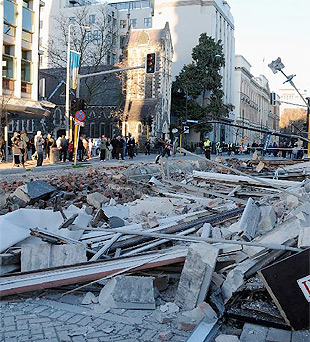Aftershocks Continue Ravaging Christchurch, New Zealand
 On Saturday, September the fourth at 4.35am, when most of the inhabitants of Canterbury and Christchurch were asleep an earthquake hit. The 7.1 earthquake on the Richter scale was around 37 kilometres west of the city, close to a small town called Darfield. Luckily, nobody died from the earthquake; one person had a chimney fall on them and another had glass fall upon them. Damage was spread throughout Canterbury from a house falling down in Darfield (luckily nobody was hurt) to Liquefaction in many suburbs in Christchurch to buildings cracking and to facades of buildings falling off.
On Saturday, September the fourth at 4.35am, when most of the inhabitants of Canterbury and Christchurch were asleep an earthquake hit. The 7.1 earthquake on the Richter scale was around 37 kilometres west of the city, close to a small town called Darfield. Luckily, nobody died from the earthquake; one person had a chimney fall on them and another had glass fall upon them. Damage was spread throughout Canterbury from a house falling down in Darfield (luckily nobody was hurt) to Liquefaction in many suburbs in Christchurch to buildings cracking and to facades of buildings falling off.
The first quake lasted around 40 seconds, with a foreshock hitting five seconds before the big earthquake. The earthquake was felt as far south as Dunedin and was felt as far north as New Plymouth (both, obviously, still within New Zealand).
Around 20 minutes after the first shake, there was the first aftershock, which was a 5.6 on the Richter scale. From then on, until now (2 January 2011) there have been a total collective of 4,180 shakes, including the two mentioned above.
Civil Defence declared a state of emergency for Christchurch, the Selwyn District, and the Waimakariri District. There was a curfew implored within the CBD of Christchurch City, lasting from 7pm on the fourth of September to 7am the next morning. Also, The New Zealand Army was deployed to the worst affected areas and to make sure that nobody got into the curfew area.
The earthquakes slowly began to die down after around a month of near-constant shakes; including several in the middle of the night that the inhabitants of Canterbury surely felt and were woken by. As the earthquakes began dying down, they became smaller and smaller on the Richter scale. Sooner or later, we became very used to them and every time there was an earthquake, we would notice them less and less.
Until December 26, 2010 (sometimes called Boxing Day), when there was yet another set of aftershocks, when there hadn’t been any that we weren’t used to. These aftershocks were different to the very first earthquake in that they were centered much, much closer to the center of Christchurch and some people thought that it was a whole new earthquake on a different fault line. On that one day, there were 26 different earthquakes, beginning with a 4.2 at around 2am. The most notable earthquake of that day was a 4.9 at 10.30am and was merely 3 kilometres from the central city. This single earthquake caused yet more damage, and this time was more within the center of Christchurch and even caused the Central Business District (CBD) to be closed until Wednesday of that week. The officials from the Earthquake Commission (EQC) had to re-check every single building in the CBD. And again, most were given clearance. About five shops in the CBD are now ‘red stickered’ because of this latest aftershock. But like the very first earthquake this ‘aftershock’ caused power outages to more than 40,000 residents for quite some time, however, not as long as the original shake.
Despite the aftershocks continuing to wreak havoc on Christchurch, the residents have begun to get used to the shakes. Already today, there have been two separate quakes and both were in between 2.7 and 2.9 and were in the early hours of this morning.
There’s not much the residents can actually do about the earthquakes except grin and bear them, until they’re over. Truly, nobody knows when they are going to end, not even the seismic experts...even though they try really well to predict when they are going to end.
Extra Information
2010 Canterbury Earthquake Wikipedia page
Christchruch Quake Map - A website that the University of Canterbury students started up to plot every single one of the earthquakes.
Latest articles
-

Charleston Church Shooting
July 1st, 2015 at 12:28am
-

Lolita Fashion
September 22nd, 2014 at 07:56am
-

Exploring Asexuality
September 5th, 2014 at 02:02am
-

Should Flights Into Israel Be Stopped?
July 23rd, 2014 at 06:33pm
-

Bring Back Our Girls
May 7th, 2014 at 11:45pm
